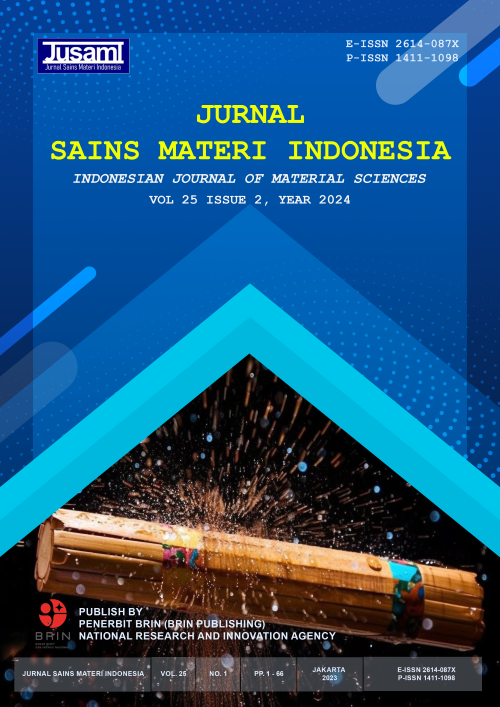Nitrogen-doped Carbon Dots Derived from Green Algae and Ammonia as Photocatalyst Material
DOI:
https://doi.org/10.55981/jsmi.2024.2552Keywords:
Green algae, Carbon dots, Hydrothermal, Photocatalyst, nitrogenAbstract
Carbon dots are a novel carbon-based material with the appealing properties of inexpensive nanomaterials, low toxicity, environmental tolerance, abundance, photostability, and simplicity of synthesis. Carbon dots (CDs) have effectively distinguished themselves from other materials due to their superior properties, such as ultra-small size, good photostability, excellent biocompatibility, and tunable fluorescence properties. This study synthesized carbon dots from green algae using a hydrothermal method at 180 °C and doped with nitrogen. Green algae contain carbohydrates, proteins, and poly-unsaturated fatty acids, allowing them to produce more carbon and be used as a precursor in synthesizing carbon dots. The FT-IR and UV-Vis spectra reveal the distinct functionalization and energy gap between the surface states of CDs and N-CDs. The carbon nanoparticles were then used as photocatalysts to degrade methyl red. The results indicate that nitrogen doping is superior for reducing methyl red and has tremendous potential for environmental applications.
Downloads
References
T. Cahyanto, E. Paujiah, I. Rinasti, Y. Suryani, A. Adawiyah, and R. A. Ulfa. “Abundance of green algae in the intertidal zone of Karang Papak Coastal, West Java, Indonesia.” J. Phys.: Conf. Ser., vol. 1402, no. 3, p. 033027, 2019.
R. Alghazeer. H. E. Fatah, S. Azwai, S. Elghmasi, M. Sidati, A. E. Fituri, E. Althaluti, F. Gammoudi, E. Yudiati, N. Talouz, G. Shamlan, A. Al-farga, W. S. Alansari, and A. A. Eskandrani. “Nutritional and nonnutritional content of underexploited edible seaweeds.” Aquaculture Nutrition, vol. 2022, 2022.
J. Zhang, X. Liu, J. Zhou, X. Huang, D. Xie, J. Ni, and C. Ni. “Carbon dots derived from algae as H2O2 sensors: The importance of nutrients in biomass.” Nanoscale Adv., vol. 1, pp. 2151–2156, 2019.
L. Cui, X. Ren, M. Sun, H. Liu, and L. Xia. “Carbon dots: Synthesis, properties and applications.” Nanomaterials, vol. 11, no. 12, p. 3419, 2021.
A. Sciortino, A. Cannizzo, and F. Messina. “Carbon nanodots: A review—From the current understanding of the fundamental photophysics to the full control of the optical response.” C, vol. 4, no. 4, p. 67, 2018.
C. Jiang, H. Wu, X. Song, X. Ma, J. Wang, and M. Tan. “Presence of photoluminescent carbon dots in Nescafe® original instant coffee: Applications to bioimaging.” Talanta, vol. 127, pp. 68–74, 2014.
H. Shabbir, E. Csapó, and M. Wojnicki. “Carbon quantum dots: The role of surface functional groups and proposed mechanisms for metal ion sensing.” Inorganics, vol. 11, no. 6, p. 262, 2023.
G. S. Das, J. P. Shim, A. Bhatnagar, K. M. Tripathi, and T. Kim. “Biomass-derived carbon quantum dots for visible-light-induced photocatalysis and label-free detection of Fe(III) and ascorbic acid.” Sci. Rep., vol. 9, p. 15084, 2019.
T. Quaid, V. Ghalandari, and T. Reza. “Effect of synthesis process, synthesis temperature, and reaction time on chemical, morphological, and quantum properties of carbon dots derived from loblolly pine.” Biomass, vol. 2, no. 4, pp. 250–263, 2022.
V. Manikandan and N. Y. Lee. “Green synthesis of carbon quantum dots and their environmental applications.” Environmental Research, vol. 212 part B, p. 113283, 2022.
C. Kang, Y. Huang, H. Yang, X. F. Yan, and Z. P. Chen. “A review of carbon dots produced from biomass wastes.” Nanomaterials, vol. 10, no. 11, p. 2316, 2020.
M. N. Egorova, A. E. Tomskaya, A. N. Kapitonov, A. A. Alekseev, and S. A. Smagulova. “Hydrothermal synthesis of luminescent carbon dots from glucose and birch bark soot.” Journal of Structural Chemistry, vol. 59, no. 4, pp. 780–785, 2018.
R. Liu, J. Zhang, M. Gao, Z. Li, J. Chen, D. Wu, and P. Liu. “A facile microwave-hydrothermal approach towards highly photoluminescent carbon dots from goose feathers.” RSC Adv., vol. 5, no. 6, pp. 4428–4433, 2015.
B. Zhi, M. J. Gallagher, B. P. Frank, T. Y. Lyons, T. A. Qiu, J. Da, A. C. Mensch, R. J. Hamers, Z. Rosenzweig, D. H. Fairbrother, and C. L. Haynes. “Investigation of phosphorous doping effects on polymeric carbon dots: Fluorescence, photostability, and environmental impact.” Carbon, vol. 129, pp. 438–449, 2018.
G. Kandasamy. “Recent advancements in doped/Co-doped carbon quantum dots for multi-potential applications.” C, vol. 5, no. 2, p. 24, 2019.
R. Atchudan, T. N. J. I. Edison, S. Perumal, R. Vinodh, and Y. R. Lee. “Betel-derived nitrogen-doped multicolor carbon dots for environmental and biological applications.” Journal of Molecular Liquids, vol. 296, p. 111817, 2019.
H. Lv, H. Zhao, T. Cao, L. Qian, Y. Wang, and G. Zhao. “Efficient degradation of high concentration azo-dye wastewater by heterogeneous Fenton process with iron-based metal-organic framework.” Journal of Molecular Catalysis A: Chemical, vol. 400, pp. 81–89, 2015.
A. Amari, V. K. Yadav, S. K. Pathan, B. Singh, H. Osman, N. Choudhary, K. M. Khedher, and A. Basnet. “Remediation of methyl red dye from aqueous solutions by using biosorbents developed from floral waste.” Adsorption Science & Technology, vol. 2023, pp. 1–17, 2023.
K.-W. Chu, S. Lee, C.-J. Chang, and L. Liu. “Recent progress of carbon dot precursors and photocatalysis applications.” Polymers, vol. 11, no. 4, p. 689, 2019.
H. Wang, P. Sun, S. Cong, J. Wu, L. Gao, Y. Wang, X. Dai, Q. Yi, and G. Zou. “Nitrogen-doped carbon dots for ‘green’ quantum dot solar cells.” Nanoscale Res. Lett., vol. 11, p. 27, 2016.
C. Jin, C. Ge, Z. Jian, and Y. Wei. “Facile synthesis and high photocatalytic degradation performance of ZnO-SnO2 hollow spheres.” Nanoscale Research Letters, vol. 11, p. 526, 2016.
J. Ke, X. Li, Q. Zhao, B. Liu, S. Liu, and S. Wang. “Upconversion carbon quantum dots as visible light responsive component for efficient enhancement of photocatalytic performance.” Journal of Colloid and Interface Science, vol. 496, pp. 425–433, 2017.
S. Thulasi, A. Kathiravan, and M. Asha Jhonsi. “Fluorescent carbon dots derived from vehicle exhaust soot and sensing of tartrazine in soft drinks.” ACS Omega, vol. 5, no. 12, pp. 7025–7031, 2020.
B. Rooj and U. Mandal. “A review on characterization of carbon quantum dots.” Vietnam Journal of Chemistry, vol. 61, no. 6, pp. 693–718, 2023.
L.-M. Shen and J. Liu. “New development in carbon quantum dots technical applications.” Talanta, vol. 156–157, pp. 245–256, 2016.
J. Ren, F. Weber, F. Weigert, Y. Wang, S. Choudhury, J. Xiao, I. Lauermann, U. Resch-Genger, A. Bande, and T. Petit. “Influence of surface chemistry on optical, chemical and electronic properties of blue luminescent carbon dots.” Nanoscale, vol. 11, pp. 2056–2064, 2019.
N. K. Khairol Anuar, H. L. Tan, Y. P. Lim, M. S. So’aib, and N. F. Abu Bakar. “A review on multifunctional carbon-dots synthesized from biomass waste: Design/fabrication, characterization and applications.” Front. Energy Res., vol. 9, p. 626549, 2021.
C. Huang, H. Dong, Y. Su, Y. Wu, R. Narron, and Q. Yong. “Synthesis of carbon quantum dot nanoparticles derived from byproducts in bio-refinery process for cell imaging and in vivo bioimaging.” Nanomaterials, vol. 9, no. 3, p. 387, 2019.
J.-R. Macairan, T. V. De Medeiros, M. Gazzetto, F. Yarur Villanueva, A. Cannizzo, and R. Naccache. “Elucidating the mechanism of dual-fluorescence in carbon dots.” Journal of Colloid and Interface Science, vol. 606, pp. 67–76, 2022.
C. M. Carbonaro, R. Corpino, M. Salis, F. Mocci, S. V. Thakkar, C. Olla, and P. C. Ricci. “On the emission properties of carbon dots: Reviewing data and discussing models.” C, vol. 5, no. 4, p. 60, 2019.
K. Akbar, E. Moretti, and A. Vomiero. “Carbon dots for photocatalytic degradation of aqueous pollutants: Recent advancements.” Advanced Optical Materials, vol. 9, no. 17, p. 2100532, 2021.
Downloads
Published
How to Cite
Issue
Section
License
Copyright (c) 2024 Erna Hastuti, Z. Mutiara, T. Kurniati, U. Hikmah

This work is licensed under a Creative Commons Attribution-ShareAlike 4.0 International License.








